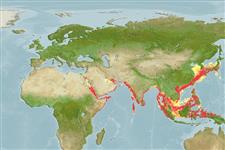Actinopterygii (ray-finned fishes) >
Anguilliformes (Eels and morays) >
Muraenesocidae (Pike congers)
Etymology: Muraenesox: Latin, muraena = morey eel + Esox, old name for pike (Ref. 45335).
Environment / Climate / Range
Ecology
Marine; freshwater; brackish; demersal; oceanodromous; depth range ? - 800 m (Ref. 100719), usually ? - 300 m (Ref. 9942). Subtropical, preferred 28°C (Ref. 107945); 47°N - 4°S, 30°E - 143°E (Ref. 54598)
Indo-West Pacific: Red Sea, Persian Gulf, west coast of India, and Sri Lanka to Fiji and Tuvalu (Ref. 12596), north to Japan and Korea, south to the Arafura Sea (Ref. 9819) and northern Australia. Migrated to the Mediterranean via the Suez Canal (Ref. 6724).
Size / Weight / Age
Maturity: Lm ? range ? - ? cm
Max length : 220 cm TL male/unsexed; (Ref. 559); common length : 80.0 cm TL male/unsexed; (Ref. 3397); max. reported age: 15 years (Ref. 72462)
Dorsal
spines
(total): 0;
Anal
spines: 0;
Vertebrae: 145 - 159. Snout long; eye diameter 2-2.5 times in snout length; posterior nostrils much closer to eyes than to anterior nostrils; mouth very large; teeth generally large and conspicuous (Ref. 4832). Head broader, interorbital about 8 times in head; lateral-line pores before anus 44-47; dorsal-fin rays before anus 66-78; vertebrae 145-159 (Ref. 9830).
Occurs from the littoral zone to the upper bathy-benthic region (Ref. 9942, 11230). Inhabits soft bottoms (Ref. 11230), also found in estuaries. Sometimes enters freshwater environment (Ref. 9987). Feeds on small bottom fishes and crustaceans. Captured and cultured for fishery in Japan. Marketed mainly fresh (Ref. 7238). Also used as bait for shark fishing (Ref. 2872). Also caught by bag (dol) nets. Used in Chinese medicine (Ref. 12166).
Life cycle and mating behavior
Maturity | Reproduction | Spawning | Eggs | Fecundity | Larvae
Masuda, H., K. Amaoka, C. Araga, T. Uyeno and T. Yoshino, 1984. The fishes of the Japanese Archipelago. Vol. 1. Tokai University Press, Tokyo, Japan. 437 p. (text). (Ref. 559)
IUCN Red List Status (Ref. 115185)
CITES (Ref. 94142)
Not Evaluated
Threat to humans
Harmless
Human uses
Fisheries: highly commercial; aquaculture: commercial; gamefish: yes; bait: occasionally
More information
Common namesSynonymsMetabolismPredatorsEcotoxicologyReproductionMaturitySpawningFecundityEggsEgg development
Tools
Special reports
Download XML
Internet sources
